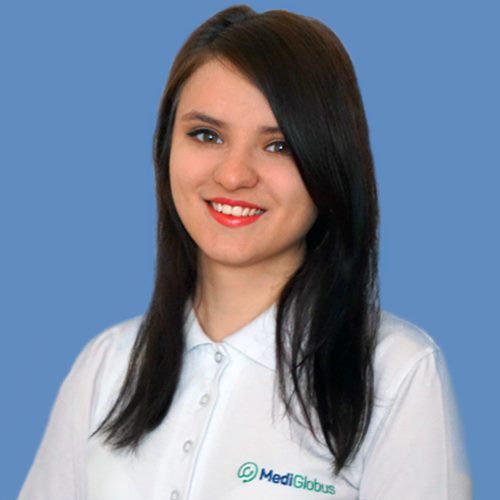Every second in the world, someone is experiencing a stroke. However, according to public opinion polls, most people can not name more than two signs of the disease. To support the World Stroke Day and create awareness in people MediGlobus decided to fill these information gaps. Important questions about stroke are answered below by a practicing neurologist.
Read in the article:
What are the main causes of stroke? Who is at risk?
What are the first signs of stroke?
Stroke in women and men: is there any difference?
Tell us about the help needed after stroke? What are the algorithm of actions?
What could you advise for the prevention of stroke?
WHAT ARE THE MAIN CAUSES OF STROKE? WHO IS AT RISK?

REASONS OF CEREBRAL CIRCULATION DISORDERS CAN BE FOLLOWING:
- rheumatic heart disease,
- diseases of the veins of the lower extremities,
- atherosclerosis,
- arterial hypertension,
- trauma, pathology of the vascular wall,
- atrial fibrillation,
- pathology of carotid arteries,
- thromboembolism.
All these diseases can lead to one or another type of violation of the blood circulation of the brain. Most often, cardiac and vascular pathology are the causes of stroke.
RISK FACTORS OF DEVELOPING STROKE:
- bad habits (smoking, alcohol),
- age (the older the person, the higher the risk, in patients older than 60 years the risk of stroke is 20 times higher than up to 45 years),
- low physical activity,
- state of frequent emotional stress,
- malnutrition,
- heredity (stroke, hypertension in relatives in anamnesis),
- obesity, diabetes, arterial hypertension, atherosclerosis (the largest predisposing factors of stroke development).
- The results of the studies by American Medical Association confirm that depression is also one of the risk factors. People prone to this mental disorder increase the chance of developing stroke by 45%.
In addition, people with sleep apnea are more likely to have stroke (involuntary delay of breathing during sleep).
Many people think that stroke is a disease of aged people. However, statistics tell us that in recent years it has significantly “grown younger”. For example, in America, from 1995 to 2008, the number of patients with stroke between the ages of 5 and 44 years increased by more than 30%. In the US, more than 4,000 children suffer a stroke each year! Cautious you have to be with everything, without exception. Young people often misjudge their condition: they take stroke for a headache or the consequences of alcohol.
WHAT ARE THE FIRST SIGNS OF STROKE?
It is possible to distinguish a group of so-called pointers of stroke:
- headache, dizziness and weakness,
- presence of nausea and vomiting,
- sweating, rush of blood to the face.
All this can be accompanied by a change in the pulse, disorder of speech and movements coordination, violation of the sensitivity of different parts of the body and face. There is an algorithm for self-diagnosis of stroke. It is called F.A.S.T. where each letter denotes a certain action:
- F (Face): when you ask the patient to smile, one side of the face will not respond properly, the corner of the mouth will be lowered down.
- A (Arms – HANDS): ask to raise both hands up, with stroke one hand will be lower, for patient it will be difficult to raise the second.
- S (Speech – SPEECH): ask a person to give his name – as a rule, a person will have speech disorders, and he can not pronounce his name or a simple sentence.
- T (Time): an important criteria for successful treatment and survival is time, if you have suspected a stroke – immediately call an ambulance.
In patients with developed stroke, hearing impairment, incomprehension of speech addressed to him, convulsions, complete or partial paralysis of the limbs, involuntary urination and defecation are not uncommon.
Few people know this today that there is a special portable video oculogram. This is accelerometer and special glasses, which must be put on and connected to the computer. The device is able to reliably determine whether the patient’s symptoms are caused by a stroke.
STROKE IN WOMEN AND MEN: IS THERE A DIFFERENCE?
According to statistics, the rehabilitation of women after a stroke is longer, besides, women more often die from this disease. Negative consequences in this matter is smoking: women with this habit are more prone to stroke than smoking men. As for the symptoms: there is no difference between the symptoms of stroke in men and women, and their severity varies depending on the zone and location of the lesion.
TELL US ABOUT THE HELP NEEDED WITH STROKE? WHAT IS THE ALGORITHM OF ACTIONS?
With stroke assistance should be provided in a specialized medical facility by a team of specialists. Therefore, if you suspect a person having a stroke, call a healthcare team as soon as possible. This is literally a matter of life and death. For each minute about 2 million cells die in the patient’s brain. The less time passes until the provision of comprehensive medical care, the more the patient has a chance to live.
WHAT COULD YOU ADVISE FOR PREVENTION OF STROKE?

For the prevention of stroke it is very important to lead a healthy lifestyle, eat regularly and efficiently, do constant moderate exercises, give up bad habits. It is necessary to undergo preventive examinations annually, in order to reveal the development of predisposing diseases in advance.
It is also worth recalling one of the American discoveries about tomatoes. As scientists have found, the pigment of lycopene, which is present in this vegetable,helps in reducing risk of stroke. People with a high content of lycopene in the blood are 55% less prone to the disease.
Patients with chronic diseases should strictly adhere to the recommendations of the attending physician and closely monitor their own health. In time, take medications, adjust with the doctor’s dose if necessary. Particular attention should be paid to the arterial pressure in patients with hypertension.






